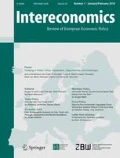Abstract
Islamic banking, where fixed interest contracts are banned, needs if it is to be successful to operate within a type of financial system in which bank-industry relationships are sufficiently close and pervasive for profit- and loss-sharing arrangements to be acceptable to both sides. However, the creation of such a business culture is likely to be difficult.
Similar content being viewed by others
References
See, for example, I. Karsten: Islam and financial intermediation, IMF Staff Papers, 29, 1982, pp. 108–42; F. L. Pryor: The Islamic economic system, in: Journal of Comparative Economics, 9/1985, pp. 197–223; N. A. Saleh: Unlawful Gain and Legitimate Profit in Islamic Law, Cambridge University Press, 1986; Z. Iqbal and A. Mirakhor: Islamic Banking, IMF Occasional Paper No. 49; S. Ahmed: Islamic banking and finance: a review essay, in: Journal of Monetary Economics, 24/1989, pp. 157–67; and the collection of papers in M. S. Khan and A. Mirakhor (eds.): Theoretical Studies in Islamic Banking and Finance, Institute for Research and Islamic Studies, Houston 1987.
See, for example, M. S. Khan: Islamic interest-free banking: a theoretical analysis, in: IMF Staff Papers No. 33, pp. 1–27.
See, for example, M. S. Khan and A. Mirakhor: The financial system and monetary policy in an Islamic economy, in: M. S. Khan and A. Mirakhor (eds.), op. cit..
See, for example, N. U. Haque and A. Mirakhor: Saving behaviour in an economy without fixed interest, in: M. S. Khan and A. Mirakhor (eds.), op. cit.,. N. U. Haque and A. Mirakhor: Optimal profit-sharing contracts and investment in an interest-free economy, in: M. S. Khan and A. Mirakhor (eds.), op. cit. Theoretical Studies in Islamic Banking and Finance, Institute for Research and Islamic Studies, Houston 1987.
For surveys of the relevant literature see C. A. E. Goodhart: Money, Information and Uncertainty, 2nd edition, London 1989, chapter V; M. K. Lewis: Theory and practice of the banking firm, in: C. J. Green and D. T. Llewellyn (eds.): Financial Markets and Institutions, Oxford 1991; and J. Chant: The new theory of financial intermediation, in: K. Dowd and M. K. Lewis (eds.): Current Issues in Financial and Monetary Economics, London 1992.
See, in particular, D. Gale and M. Hellwig: Incentive-compatible debt contracts: the one-period problem, in: Review of Economic Studies, 52/1985, pp. 647–63.
Cf. the analysis of W. M. Khan (Towards an Interest-free Islamic Economic System, The Islamic Foundation, Leicester 1985).
See C. Mayer: New issues in corporate finance, in: European Economic Review, 32/1988, pp. 1167–89; M. Hellwig: Banking, financial intermediation and corporate finance, in: A. Giovannini and C. Mayer (eds.): European Financial Integration, 1991. The distinction is sometimes described as that between “market-based” and “bank-based” financial systems, or—with an emphasis on the control of enterprises—between “outsider-control” and “insider-control” systems; see also J. Corbett and C. Mayer: Financial Reform in Eastern Europe: progress with the wrong model, in: Oxford Review of Economic Policy, 7/4, 1991, pp. 57–75.
See, for example, P. Collier and C. Mayer: The assessment: financial liberalisation, financial systems and economic growth, in: Oxford Review of Economic Policy, 5/4, 1989, p. 1–12; and J. E. Stiglitz: Financial markets and development, in: Oxford Review of Economic Policy, 5/4, 1989, pp. 55–68. For a similar argument on the liberalising Eastern European economies see J. Corbett and C. Mayer, op. cit. Financial Reform in Eastern Europe: progress with the wrong model, in: Oxford Review of Economic Policy, 7/4, 1991, pp. 57–75.
I. Karsten, op. cit. Islam and financial intermediation, IMF Staff Papers, 29, 1982, pp. 108–42.
See M. S. Khan and A. Mirakhor: Islamic banking: experiences in the Islamic Republic of Iran and in Pakistan, in: Economic Development and Cultural Change, 38/1990, pp. 353–75.
See N. A. Salen, op. cit. Unlawful Gain and Legitimate Profit in Islamic Law, Cambridge University Press, 1986. The most widely quoted reference on the stock exchange in an Islamic system is M. M. Metwally (The role of the stock exchange in an Islamic economy, in: Journal of Research in Islamic Economics, 2/1984, pp. 21–30)
C. Mayer, op. cit. New issues in corporate finance, in: European Economic Review, 32/1988, pp. 1167–89.
M. S. Khan and A. Mirakhor: Islamic Banking..., op. cit. experiences in the Islamic Republic of Iran and in Pakistan, in: Economic Development and Cultural Change, 38/1990, pp. 353–75.
See T. Naughton and B. Shanmugam: Interest-free banking: a case study of Malaysia, in: National Westminster Bank Quarterly Review, February 1990, pp. 16–32; and M. Ariff: Islamic banking in Malaysia: framework, performance, and lessons, in: Journal of Islamic Economics, 2/1989, pp. 67–78.
Author information
Authors and Affiliations
Rights and permissions
About this article
Cite this article
Cobham, D. Finance for development and islamic banking. Intereconomics 27, 241–244 (1992). https://doi.org/10.1007/BF02928053
Issue Date:
DOI: https://doi.org/10.1007/BF02928053



